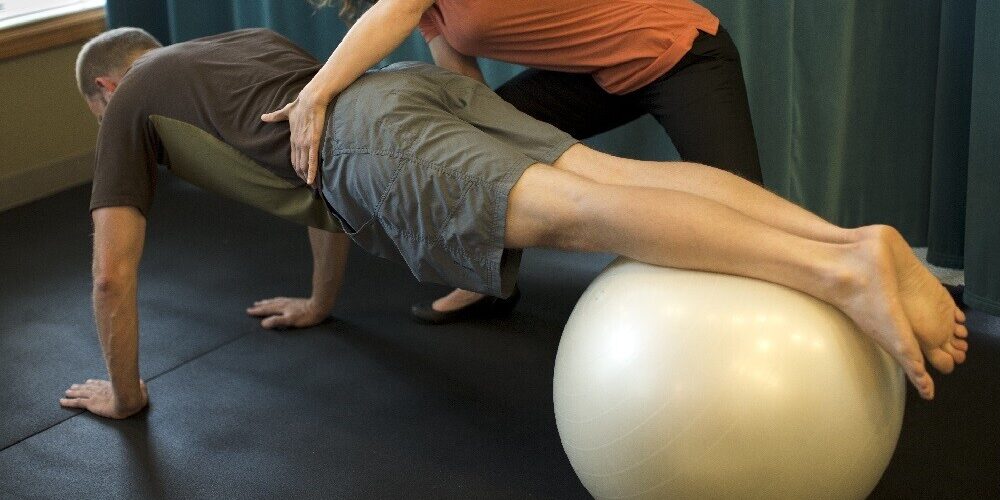If you’ve experienced lower back pain, you’re not alone. About 80 percent of adults have it at some point in their lives. It’s the most common cause of job-related disability, a leading contributor to missed work days and the single leading cause of disability worldwide1. In surveys, more than a quarter of adults report experiencing low back pain during the past 3 months2. We treat this diagnosis more frequently than any other. For that reason, we’re here to answer your questions, inform you about the research and maybe even bust some myths.
Spoiler alert — physical therapy (PT) is one of the most economical 3, 4, safe 5 and effective 5, 6 ways to treat most cases of lower back pain.
Doctors and Medications
Should I see my doctor for lower back pain?
If your back pain started immediately after a fall or if a fracture is suspected, visit your doctor before starting physical therapy. Additionally, your insurance may require a referral for PT. If so, call or see your doctor to request a referral so we can bill your insurance for you.
Other than those instances, it’s more effective to see a physical therapist first.4 Usually, our findings are routine and point to a typical pattern of pain. In that case, we prescribe a home exercise program to do in conjunction with your physical therapy treatments. If we find a reason for you to see your doctor, we’ll let you know right away. To keep all lines of communication open, we always send your doctor a summary of our initial assessment, your progress, and in the end we let them know when we discontinue your physical therapy episode.
I saw my doctor and all they did was refer me to physical therapy. Isn’t there anything else they can do?
Fist bump! You’ve chosen a good doctor who’s read the research and knows the best place for you to start.6 Yes, doctors can prescribe medicines and order imaging, but increasingly, the research supports not doing this from the get-go. 3, 7, 8, 9, 10, 11
Do I need prescription medications for lower back pain?
Not necessarily. It’s important to note that there are no medications that fix lower back pain, only minimize symptoms. Unfortunately, all prescription drugs come with side-effects.
The most common medications prescribed for lower back pain are Nonsteroidal Anti-Inflammatory Drugs (NSAIDS) and muscle relaxants. NSAIDS can take the edge off. These come with the side effects of delayed tissue healing and an upset stomach. Muscle relaxants help during a gripping muscle spasm, but they can make you drowsy. Therefore, most people can only take them at night.
A course of oral steroids is sometimes prescribed when there are high levels of pain or you have pain, numbness or tingling going down the leg. If steroids are prescribed to you, they should be started while you are undergoing physical therapy. The window of relief you may experience is best supported with exercises and treatment that will aid in the return of mobility. Short-term steroids weaken your immune system and come with these side effects: irritability, trouble sleeping, restlessness, weight gain, thinning skin and more.
Opioid pain-killers are highly addictive. For that reason, all conservative options should be exhausted before using opioid pain-killers for lower back pain.6
Imaging

Should I have imaging for lower back pain? *This is THE most common question we get!*
The short answer is NO. Unless you have red flags, imaging doesn’t usually provide information that will change the way we treat your specific problem. Plus, it increases the over-all cost of treatment, exposes you to unnecessary radiation and might find things that you’ll feel bummed about the rest of your life (happens all the time!). For example, many people have degenerative changes in their spine but have no symptoms. As a result, finding something like this makes you worry and feel old or broken. What’s worse, it distracts you from the proactive steps you can take to get rid of the pain.7
Sadly, sometimes imaging for lower back pain can actually be worse than useless, because it can send you down a path of trying to fix something that may have nothing to do with the pain you’re experiencing. For example, we have seen patients who’ve had surgery for a finding on imaging that was assumed to be the culprit for their pain, but actually wasn’t causing it.
Unfortunately, patients are often the ones demanding imaging. In the absence of red flags, healthcare providers ordering imaging for lower back pain either aren’t current on the research or are caving to their patient’s demands.3, 7, 8, 9, 10
How can PTs fix lower back pain if we don’t know exactly what’s wrong?
Humans are complex (and interesting). If we were robots we could run some diagnostics, write some code, switch out parts and be good as new. Back pain is a symptom that can get better even if we don’t know the exact cause. As a human, every—single—thing about you is unique. Your DNA, life experiences, daily activities, diet, exercise, posture, mental outlook, over-all health (etc…) all feed into how you experience pain. A picture of your spine isn’t sophisticated enough to reveal all of your unique characteristics.
Physical therapists use systematic movement testing, assessment of specific muscles and special tests to identify the areas that cause your pain. The physical therapy exam takes you as a person into consideration and is much more sophisticated than a snapshot of an image.
I’ve had imaging and it didn’t show anything. Why am I in pain?
Studies have shown that imaging a random sample of people with NO symptoms results in a large percentage of people who have findings like degeneration, disk bulges and even nerve root compression. Conversely, patients who ARE experiencing symptoms can have NO findings on imaging. Those same studies reveal that depression, rather than findings on imaging, is a more important predictor for developing lower back pain.7, 11 Ultimately, pain is a complex personal experience with multiple factors contributing to it.
Activities and Exercise

Which exercises or activities should I avoid with lower back pain?
The only uniformly recommended treatment for lower back pain in the literature is exercise.13 However, it’s good to modify activities that increase pain. Ideally, the exercises your physical therapist prescribes should be pain-free or not increase your baseline level of pain. Sometimes, it isn’t the activity that’s the problem, but the way that you’re performing it. Physical therapists are experts at teaching the correct way to exercise, correct posture, and instruct in proper body mechanics and lifting techniques.
Which exercises or activities should I do for lower back pain?
Movement is the best medicine for lower back pain. However, we can’t say uniformly that all patients experiencing low back pain should participate in a certain set of exercises. Your physical therapist will assess your movement, restrictions, function, breathing and much more to come up with a unique home exercise program specific to you.
How long does low back pain last?
Generally, an acute episode of lower back pain is one that lasts up to 6 weeks. A sub-acute episode is one lasting 6-12 weeks, and chronic lower back pain lasts more than 12 weeks.13
Will my low back pain come back?
Estimates of having a recurrence in the first year after an episode range from 24% to 80%14. But, don’t get discouraged just yet because here’s what we see: patients who actively participate in therapy (do their home exercise program; change daily habits; reach all their activity goals) are much less likely to experience a recurrence.
Those that see healthcare as a passive experience (i.e. you fix me) tend to experience higher rates of recurrence. Similarly, patients often stop therapy after getting pain-relief from a few sessions of PT. Unfortunately, the problem hasn’t magically gone away. Odds are the pain will return within the year unless you’ve addressed any underlying imbalances.
Red Flags: Signs & symptoms the warrant more testing

What are Red Flags for lower back pain?
Red flags are symptoms that require a visit to your doctor who can order the appropriate tests. Although serious problems related to low back pain are exceptionally rare, we would be remiss not to mention them. Red flags:
- Recent fall (that started your low back pain)
- Fever
- Saddle anesthesia (numbness or tingling in the perineum)
- Sudden bowel or bladder changes (loss of control or inability to go)
- Progressive weakness over a short period of time (e.g. I could move my big toe yesterday, but today I can’t)
To keep things in perspective, the incidence of scary problems is low. The chance of cancer causing low back pain is 0.7%. Compression fractures make up 4% of causes and 0.01% of causes are due to spinal infection.7
Move Consciously. Live Fully.
Above all, celebrate how unique you are by listening to and trusting your body. Change simple daily habits. Move your body more often and more consciously. Experience the fullness of life. Certainly, approaching recovery with this mindset results in personal discoveries and long-lasting rewards.
Watch this Great Video on Lower Back Pain
References
2Back Pain Prevalence and Visit Rates: Estimates From U.S. National Surveys, 2002
9Imaging the back pain patient
14The Epidemiology of low back pain
If there are affiliate links on this page, we may earn a small commission on qualified purchases. We only endorse products that we trust or have used. We hope you find value in our recommendations and utilize the provided links to purchase.
Disclaimer